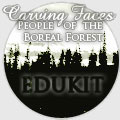Mint

A number of plants are also used to make drinks. Mint grows wild on the banks of beaver dams. It can be dried and preserved, or put fresh into hot water. Either way, it makes a refreshing tea.
-Terry Garvin, Carving Faces, Carving Lives: People of the Boreal Forest
There are actually a few thousand plants that can be classified in the overall family of mint, but one plant in the family, specifically called wild mint, is commonly spoken of in terms of its traditional uses. The wild mint, known as tsá tlh’ ogh tsёné to the Chipewyan, eto n detsī to the Slave, and amisko wehkuskwa (among various other names) to the Cree, is a perennial herb common to boreal forests around the world. Wild mint is often found near beaver dams, or on the banks of rivers, streams, or other bodies of water. It grows straight, usually ranging from fifteen to fifty centimetres in height. It has egg shaped, serrated edged leaves that grow in opposite pairs along its squarish stem. These leaves are quite aromatic and have a number of uses among the peoples of the northwest. The wild mint is a wildflower, and grows clusters of tiny blossoms on the stem at the centre of its leaf pairs. These flowers, pink, white, or pale purple in colour, could also be used in various ways.
Traditional Uses:
A common use of the wild mint among the peoples of the boreal forest was as a tea, either recreationally or medicinally. The leaves of the plant were collected, dried, and boiled in water for this purpose. The leaves were also used as an herb to season other foods, and mixed with bait to lure animals like red foxes and lynx into traps. The ground leaves could be used along with ground stems to relieve the symptoms of toothaches.
The flowers of wild mint could be ground, placed in a cloth, and moistened. The moistened cloth with the ground flowers was used to wash infected gums. The flowers could also be packed along with leaves into a nostril to stop a severe nosebleed.





